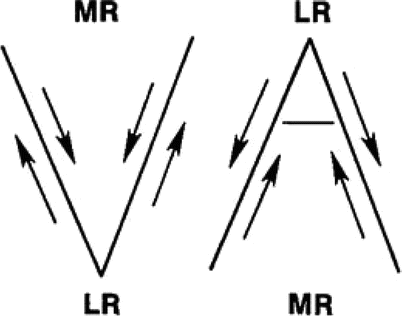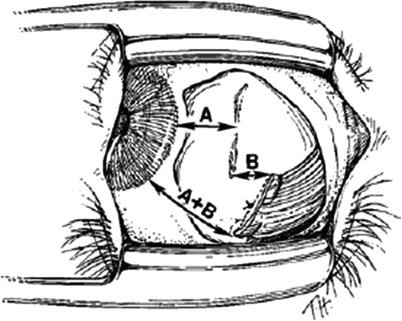and Yi Ning J. Strube2
(1)
Wright Foundation for Pediatric Ophthalmology and Adult Strabismus Medical Center, Los Angeles, CA, USA
(2)
Queen’s University, Kingston, Ontario, Canada
Keywords
A patternV patternVertical transpositionY-splitting procedureHorizontal transpositionTransposition for torsion15.1 Horizontal Rectus Muscle Transpositions for A and V Patterns
Vertical transposition of horizontal muscle insertions is an effective means of collapsing an A or V pattern (Fig. 15.1), but only if there is no significant oblique overaction. If oblique overaction is present, appropriate oblique muscle surgery should be performed.


Fig. 15.1
A medial rectus muscle (MR), whether resected, recessed, or simply transposed, is always moved toward the apex of the pattern. Thus, the medial rectus muscle is displaced inferiorly in V patterns and superiorly in A patterns. Conversely, a lateral rectus muscle (LR) is moved away from the apex, superiorly for V patterns and inferiorly for A patterns. The magnitude of the transposition usually performed is either half of a tendon width (which corrects patterns of 10–25 PD) or a full tendon width (for patterns exceeding 25 PD)
The rationale for vertical transposition is based on the observation that the strength of a horizontal rectus muscle is increased when the eye is vertically rotated in the direction opposite to the direction of its transposed insertion. For example, lowering the insertion of a horizontal rectus muscle improves the effect of this muscle when the eye is in elevation. Conversely, an elevated horizontal rectus muscle insertion produces more effect in depression. Therefore, an esotropic V pattern would best be improved by moving a recessed medial rectus muscle inferiorly, which produces more adduction in up gaze and less in down gaze. Similarly, displacing a resected lateral rectus muscle insertion superiorly decreases its abducting effect in up gaze while increasing the effect in down gaze. The result is a reduction in the size of the pattern deviation. Vertical transpositions of horizontal muscles do not appreciably alter the horizontal alignment in primary position. Figures 15.2 and 15.3 illustrate full tendon inferior transposition.


Fig. 15.2




Full tendon inferior transposition with recession. The most crucial part of the procedure is determining the site for scleral reattachment of the muscle, as it is important not to advance or recess the muscle inappropriately. The site is determined by measuring the distance to the muscle’s new insertion radially from the limbus. For a recession, the planned amount of recession (B) is added to the distance from the limbus to the original insertion (A). The surgeon first measures the amount of recession (A + B) from the limbus to the pole of the muscle closest to the original insertion. The suture is passed through the sclera in the standard fashion. The second pole of the muscle is then reattached at the same distance from the limbus (A + B), spreading the muscle poles approximately 8 mm apart. The two arms of the suture are then tied together. The reattached muscle’s leading edge parallels the curving limbus
Stay updated, free articles. Join our Telegram channel

Full access? Get Clinical Tree


